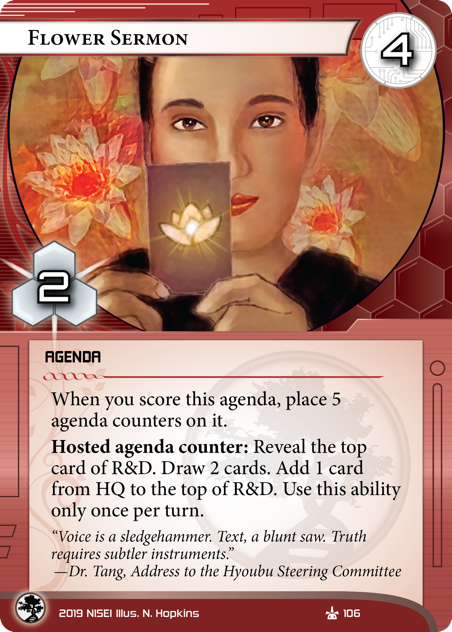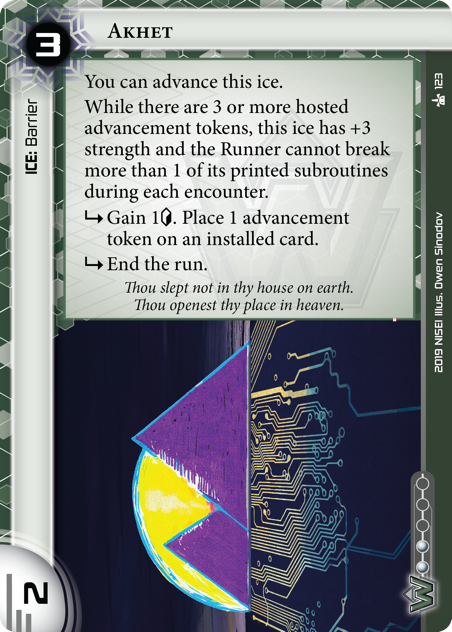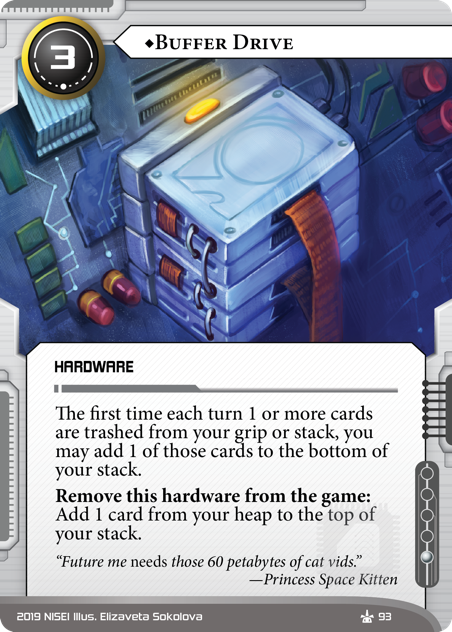Hello there, Runners! Morgan here, once again, to deliver you scoops, thoughts and likely far too heartfelt conclusions! It’s been nearly three months since I last had the pleasure of penning an article for the NISEI blog, and quite a lot has happened since then. We had our first World Championship, we announced System Gateway, and I was even able to take part in a livestream talking about that! Working with NISEI is a constant stream of engaging and exciting work, and it has always been my privilege and honour to talk about my role in all of these things. Today I am here to talk about four cards, ones that are particularly special cases from Uprising, and how they ended up becoming what they are.
But before we get down to business, there’s a few other more general things I’d like to say!
Firstly, as many of you may already know, both Greg Tongue and Patrick Burk are stepping down from their positions in NISEI. As you may expect, I’ve worked very closely with both of them over the past year in both of my roles as a Developer and Playtest Coordinator. I have the pleasure of counting them not only as incredibly capable and dedicated peers, but also as friends I’ve come to respect and love a great deal. I’ll miss working with them terribly, but I also know that friendships don’t have to end just because you stop working together! Their efforts and cooperation have been integral to making NISEI what it is today, and have only enhanced the work that I’ve personally been able to achieve here. I thank them both so very, very much.
Secondly, I recently opened up applications for playtesting for NISEI! There are applications out for both the MWL/Organised Play and Product/Set testing teams. We’ll have a formal announcement on the blog here very soon, as well as a dedicated page on the website, but for now you can find information about it either on the NISEI Facebook page, or on our Twitter, and there’s also a post about it on the Netrunner subreddit. If you’re at all interested, please check those out, or keep an eye out for the formal announcements very soon!
Lastly, this isn’t the only article I’m penning about the development of Uprising! I’m working on a joint article about our very first Champ Card, I’m overseeing an article from some of our playtesters about their work on the set, and finally I’m writing two big development rundown articles about the set as a whole. Those final two will be released at the very end of spoiler season, as accompaniments to our final articles that spoil all of the cards of the set together! I’ll also be answering any questions that the community has, to the best of my ability. You can submit questions for those articles here!
And if you’re curious about some more details on the development process for a set, please check out my first and second articles on the topic!
Alright, while I’m already talking about the involvement of people from outside the Design and Development teams, let’s start with a card that had a very troubled development process and was saved by my idle browsing of Greg’s Twitter @s and my own fixation on ensuring every card in Uprising had its own niche to one degree or another.

As you can see straight away, there’s a clear connection between Raja’s suggestion and how Flower Sermon turned out! Credit where credit is due. Not only is Raja a stellar player and one of my excellent playtesters, he’s also the primary originator of this new agenda!
Far back in the earliest iterations of not only Uprising but Ashes as a whole, we had a cycle of Jinteki cards that effectively “mimicked” other cards. We realised pretty quickly during testing that not only were these cards very difficult to balance, they were also filled with a great deal of rules-related quirks and interactions that easily broke. We’d really love to revisit those cards eventually, but we ultimately had to replace all but one of them. One became La Costa Grid, a design by Lead Developer @divadus, and the agenda became Flower Sermon.
We’d decided we really wanted to make a new 4/2 for Jinteki, as we were already giving them a 3/2 and 3/1 in Ashes, and there’s already a whole host of potent 5/3s for the faction to choose from. But there’s a big elephant in the room when you talk about 4/2s for Jinteki: Nisei Mk II. That’s a really hard act to follow, as the card is not only tremendously strong, but also inherently very well designed and balanced. Making a card that can compete with Nisei feels like a fool’s errand, to some degree.
So I decided… why compete when you can complement? Why not make a card that provides Jinteki with some powerful forward tempo and control? Something that might tempt players for one of their last couple of agenda slots, alongside their Niseis and Obokata Protocols. That’s where I spun the concept that Raja’s tweet presented, and we ramped up the sheer quantity of value you can get from the card to ensure that it was relevant and powerful. It’s also instant speed, so you can use it during the Runner’s turn to mess with their plans… The true Jinteki way!
I also ensured the card had a reveal effect, to give Hyoubu Institute that sweet little extra credit, even on the Runner’s turn. I may not be totally satisfied with where Hyoubu ended up, but I am still determined to give it love and support.
Next up, why don’t we talk about the other Corp card I have to spoil!

That’s right, your eyes do not fail you! It is indeed another one of the World Wonders ice! This is the 4th installment of the cycle, and the first one that NISEI has made! It’s already been announced that Colossus is making a comeback as a reprint in Uprising, so the whole gang will be together!
Akhet is a fantastic little glimpse of what can happen when you A) need to rework a card while trying to keep the design purpose the same and B) get to jam out ideas with the Creative team and design a card from the top down together!
One of the original Uprising prototypes was a Weyland barrier that was intended to be a sort of “anti-shenanigans” ice. Think blocking bypass, trashing, derezzing, subtype “painting” and the like. You had to break it with a fracter or you wouldn’t get through. It’s an appealing idea in theory, but in practice it created a sort of timing-based nightmare where the Runner would have to check all their instant-speed cards every single time they approached an unrezzed piece of ice. It was also just kinda boring to have a card whose sole purpose was to prevent things, rather than interact with them in more engaging ways. So, we wanted to rebuild it into something that still filled the same sort of role, at least partially, but was more interesting to use and to deal with.
That’s when I remembered Colossus was in our reprint list. Some of you have probably noticed that there’s been at least one new card for Weyland in Uprising that works with advanced ice, and with Colossus in there as well, I instantly latched on to the idea of another ice in the cycle. Chatting with @dis about the possibility of making a new one led to us settling on the Great Pyramid of Giza as the ideal landmark to use for a barrier, and from there I considered the idea of how Akhet might be about “building”… putting block on block to create something massive.
And the 3+ advancements bonus? Well, I really love Afshar, okay? The “Afshar clause” is incredible; not only does it make Akhet a very interesting piece of ice once powered up, it innoculates it against many of the existing ways in which Runners can trash ice. Kind of appropriate for one of the few world wonders that has withstood the ravages of time and is still standing today, don’t you think?
Well, why don’t we move on to a Runner card?

Buffer Drive was one of the wilder ideas to spring wholecloth from my mind, fuelled by a singular need to create a card that fulfilled a specific purpose in a novel way, and that didn’t carry with it all the baggage of previous attempts. That purpose? To be a viable tech option against grinder damage decks; Corp decks out of IDs like Potential Unleashed, Personal Evolution or Industrial Genomics that seek not to simply flatline the Runner with guile and moxie, but rather to wear them down until they have nothing left to protect them.
For a considerable portion of testing for both Downfall and Uprising we had a number of decks that were going for that exact goal, and they proved incredibly potent and frustrating to play against. While we could tweak the new cards they were using to limit these decks’ power, we also realised that there really wasn’t any Runner card out there that deliberately worked to help against grinder decks. There are cards that help, of course, your Feedback Filters or Calderas, but those cards also hurt pure kill decks in ways that are immutable and difficult for Corps to deal with. They’re also “silver bullets”—cards that neuter a specific type of enemy but are dead draws against everything else.
So, how to make a card that isn’t a silver bullet, doesn’t ruin kill decks, but works well against grinder decks? Well, I suppose the deities of tabletop gaming blessed me, because the idea for Buffer Drive’s primary ability was just something that slipped into my mind one morning as I woke up to my cat purring softly and gently pawing at my shoulder. What about an effect that didn’t prevent damage, and therefore prevent kills, but instead returned the cards lost from damage to your stack? But wait… why does it only have to be from damage? What about from “mill” effects like Breached Dome or PU? Hang on! What about MaxX? What about Patchwork?
And thus Buffer Drive was born. The secondary effect was something I added to allow the card to have additional utility even in games where you might not always need the primary effect, and it can act as a sort of pseudo-Same Old Thing. It’s a click to install Buffer Drive, a click to draw the recurred card and another click to use it, which is the exact same click investment as SOT. It’s 3 credits to install, of course, but in exchange you have the primary function and it can recur any type of card! And while it does cost an influence, we found that the card ended up being potent enough to warrant it.
The MaxX synergy was a sort of side benefit that I really loved, and Greg was instantly appreciative of it as well. An early Buffer Drive in MaxX can allow you to still leverage your ID ability, but save cards that you perhaps didn’t want to lose; squirrelling them away at the bottom of your stack to find again later. I had a great deal of games during testing where, halfway through the game, I’d play an I’ve Had Worse and be greeted by 2 Sure Gambles and a Liberated Account. What a wonderful little treat.
I’m very excited to see what players do with Buffer Drive outside of its initial purpose, be it in Patchwork or MaxX decks! Just don’t let yourself get put on a Blacklist, because no-one will sell you a good Buffer Drive if you do.
But speaking of recursion, it’s time to talk about the single most troubled card in all of Uprising: Harmony AR Therapy.

Creation and Control is rotating, and with it goes one of the most nefarious cards in Netrunner history: Levy AR Lab Access. A card that has fuelled decks both honest and controversial. The most powerful piece of recursion in the entire game (except maybe Jinteki Biotech’s The Tank), which has sat on the MWL for longer than I am able to remember.
So, the Development team found ourselves faced with a very tall task: can we make a version of Levy that won’t need to be restricted? What would that even look like, how could we achieve that goal, and what would it need to do in order to not completely gut the likes of MaxX, Geist and other decks that want to go through their deck at least a couple of times?
We started out by trying to craft a card that was functionally identical to Levy, but had a built-in mechanism that would only allow a single copy to be played for the recursion effect per game (subsequent copies would simply draw cards). Turns out that is a much more difficult problem to overcome than you’d think, especially when you’re trying to protect the card from Corp “remove from the game” effects, the lack of Same Old Thing, MaxX mills, etc.
This progressed into us trying various permutations: limiting it to once-per-game, changing its cost, removing the grip-refresh mechanic, and a bunch of different ways in which the card could bounce itself back to your grip from the heap. These were ultimately big unwieldy beasts, with clauses and abilities and interactions that made my head spin.
While we’d been working on HART (as we affectionately dubbed it), I’d been working on another card, this one in Criminal. It’s not yet spoiled, so I’ll be very vague about it, but it had also been giving me a lot of trouble in nailing down its mechanical identity. The card itself was based on a thematic concept that was strong, but what it actually did was nebulous and awkward.
That’s when I was struck with one of my most spicy of ideas. Why are we trying to remake Levy as a nearly identical card? Why not… simply let the idea of recurring your entire deck just go away forever, and remake the card as something else entirely. This is where I began thinking about how we might define recursion for each of the factions. Anarchs get to recur whatever cards they like, but only a few or with a long wait (Labor Rights, Trope). What if Shapers get to recur cards with ease, but never more than one copy of the same card at a time? And as for Crims… well, you’ll have to wait and see what I decided on for them, but it allowed me to worry less about what no Levy might do to Geist.
So, Geist is covered. MaxX now has Buffer Drive, and hopefully the meta will be in a position that we can unrestrict Labor Rights in the not-too-distant future… and thus I was able to pitch my hottest take on Levy to the Design and Development teams with confidence and a plan. The reception was warm and approving, and Greg and I hashed out exactly how we thought HART should be executed, while Dave, Zoe, and Zinos helped put the card through its paces and settle on the numerical values that we tested. Playtest was surprised, but pleasantly so, and tested the card with the eagerness that I’ve come to love and appreciate from them.
The end result was a card that plays very unlike Levy, but in a fascinating way. No longer do you need to just wait and hang on to your Levy until the last second; instead, you play HART when you have the tempo and targets to do so, often the moment you draw it. The card encourages you to consider the spread of cards in your deck, and no longer do you have to worry about shuffling back the chaff you don’t want along with everything else you do want.
And that’s it, folks! Thanks again for reading, and I hope you’ve enjoyed these newest scoops for Uprising. Join me again later this spoiler season for a more comprehensive analysis of the development process for the entire set!
